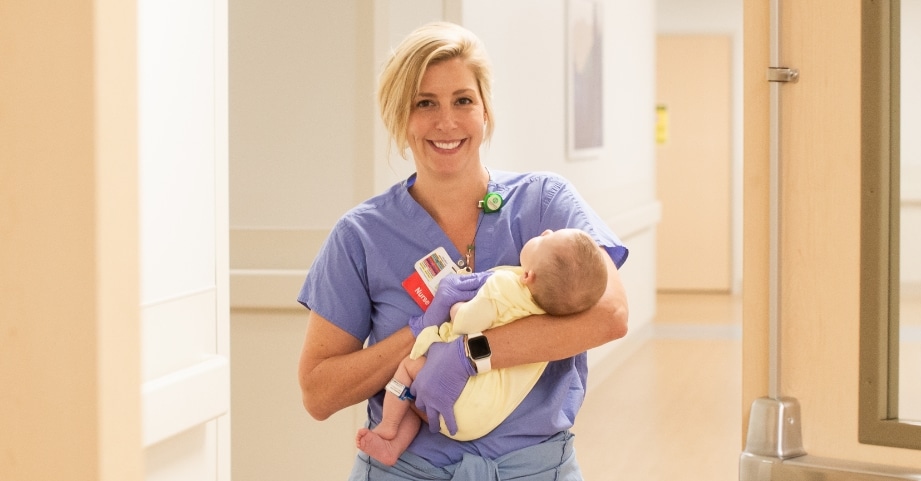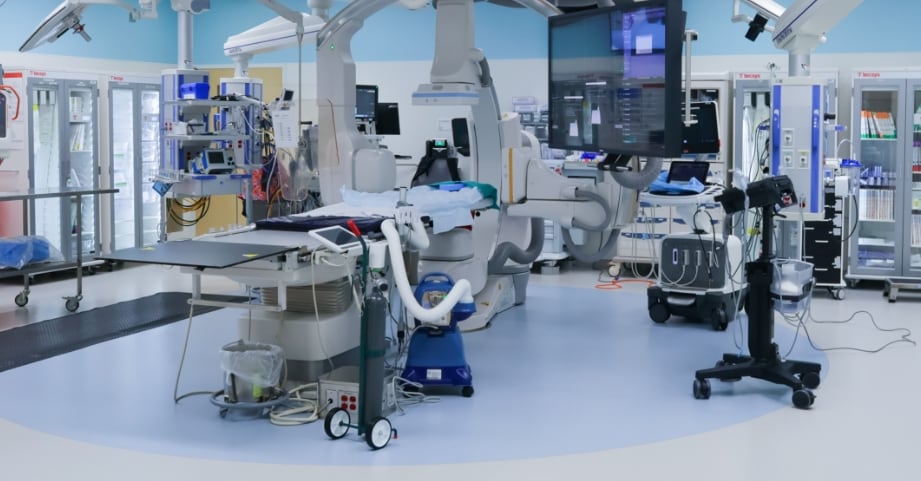Heart Catheterization for Kids
Pediatric heart catheterization is a minimally invasive procedure used to diagnose and treat heart conditions in kids. Learn more about heart catheterization and what to expect before, during and after the procedure.
A heart catheterization, also known as a cardiac catheterization or “heart cath” for short, is a minimally invasive procedure used to diagnose and treat certain heart conditions. Performed by a pediatric interventional cardiologist, a heart catheterization procedure involves inserting a thin, flexible tube called a catheter into a large vein or artery, typically in the upper leg, to gain access to the vessels and chambers of the heart.
Heart catheterization helps doctors:
- Evaluate heart function and blood flow.
- Identify abnormalities of the heart or vessels.
- Intervene to fix heart defects or improve heart function.
“Catheterization is not like surgery. We’re entering the vessels with a needle,” says pediatric interventional cardiologist James Kuo, MD. In some cases, a heart catheterization procedure can be used instead of surgery, which may allow for less pain and a shorter recovery for your child.

Diagnostic heart catheterization provides doctors with a detailed, real-time look at the heart. It may be done to:
- Measure oxygen levels, blood flow and pressures within the heart and surrounding vessels.
- Understand the structure of the heart.
- Evaluate heart valves.
Electrophysiology (EP) studies are heart catheterization procedures that are used to measure the electrical activity of the heart. EP studies are a little different from a standard diagnostic heart cath, and are performed by a pediatric cardiac electrophysiologist, a type of cardiologist who specializes in diagnosing and treating heart rhythm disorders.
“As interventional cardiologists, we call ourselves the plumbers, and the electrophysiology cardiologists are the electricians,” says Dr. Kuo. “Their catheters have wires inside of them that help map out the electrical system of the heart, while we’re more focused on blood flow and blood distribution.”
Interventional heart catheterization can sometimes be used to fix or treat certain heart conditions. In some cases, doctors use heart catheterization instead of open-heart surgery to treat congenital heart defects because there are fewer risks, particularly for smaller babies. At the Children’s Heart Center, interventional heart catheterization may be used to treat heart defects such as:
- Pulmonary vein stenosis or pulmonary artery disease: Balloon dilation (angioplasty) is used to stretch or enlarge narrowed vessels. In some cases, a stent (metal mesh tube) can be inserted in narrowed vessels to keep them propped open.
- Patent ductus arteriosus (PDA): A device is placed within the vessel to block the blood flow in the extra blood vessels.
- Atrial Septal Defect and Ventricular Septal Defect: A device is placed within the vessel to block the blood flow in the extra blood vessels.
- Heart valve abnormalities: A balloon may be inflated to widen a narrowed heart valve (called balloon valvuloplasty), or the valve may be replaced entirely in some cases if it cannot be opened or repaired.
A cardiac catheterization laboratory or “cath lab” is a dedicated procedure room for heart catheterizations. It is equipped with a variety of high-tech tools needed to diagnose and treat conditions of the heart, including an advanced X-ray imaging system that helps doctors “see” inside the heart and vessels and can provide high-resolution 3-D images.
At Children’s, our cath lab is located in the Heart Center at Arthur M. Blank Hospital, where every space has been designed especially for kids. This means all equipment is sized for smaller bodies and careful consideration has been given to kids' needs before, during and after a heart cath procedure. “There’s a cardiac prep area that is staffed by nurses who only take care of cardiac patients,” says Dr. Kuo. “They’re familiar with all aspects of congenital heart disease and heart procedures, and they’re experienced at putting kids and families at ease.”

At Children’s, you can be confident that your child is being cared for by one of the country’s leading teams of heart specialists. Unlike some hospitals that may treat both adults and children, we perform hundreds of heart catheterizations each year exclusively for babies, kids and teens, so we have the skill and equipment to navigate even the tiniest hearts.
We strive to educate patients and families before the procedure. Below are answers to some of the most common questions about the heart catheterization process.
What will be done to help keep my child comfortable before, during and after the procedure?
As a pediatric hospital, all of our spaces are designed with kids in mind, offering added touches to make them feel at ease and take their minds off their illness or treatment. Before the heart cath procedure, your child will be in a room dedicated to preparing kids for heart tests and treatments. They will be cared for by a team, including our child life specialists, who are experienced at helping kids through tough medical challenges.
“Parents often ask me, ‘Does catheterization hurt?’,” says Dr. Kuo. “The answer is no. Because during the procedure, your child will receive general anesthesia that will put them to sleep.” After the catheterization procedure, kids return to the original room to recover, so they will be in familiar surroundings.
Where will the catheter be inserted?
The catheter is usually inserted into the large vein or artery located in the crease of the upper leg. Sometimes, other blood vessels may be used instead, like the vessels in the neck. Doctors will use a local anesthetic to numb the area. They will insert a sheath or plastic tube into the vessel usually via needle puncture. And then, they’ll thread the catheter through the vein or vessel to the heart.
How long does a heart catheterization take?
How long a heart catheterization procedure lasts depends on the complexity of your child’s condition. According to Dr. Kuo, it may take anywhere from one hour to several hours to complete. Our team will keep you updated on your child’s progress throughout the procedure.
What is recovery like after heart catheterization?
Because this is a minimally invasive procedure, heart catheterization recovery is typically faster than the recovery time needed after surgery. Kids often require only one night in the hospital after heart catheterization, and many will go home the same day. Your child may have some discomfort or bruising at the site of insertion, but pain should be manageable with an over-the-counter pain reliever. Your child’s care team will give you instructions on how to manage pain.
How to care for your child after a cardiac catheterization
“A heart catheterization is a low-risk procedure, and complications are unlikely. Your child’s care team will explain the risks and be sure you’re well informed,” says Dr. Kuo. If your child is showing any of the following signs, notify your care team immediately:
- Excessive pain, numbness, discoloration or discharge at the site of insertion
- Fever
- Chest pain
- Still acting unwell or abnormally after a day or two post-procedure
As a parent, you can help your child's heart cath procedure go smoothly by following these tips:
- Follow all pre-procedure instructions from your child’s care team, including guidelines for eating and drinking, bathing and medications.
- Talk to your child about what they can expect on the day of the procedure. Reassure them that this is not a surgery. There will be minimal pain, and they will be asleep throughout the procedure.
- Encourage them to ask questions and share their concerns.
- Bring comfort items like a favorite blanket or stuffed animal on the day of the procedure to help put them at ease.
- Let your care team know if your child has any fears or concerns so we can give them extra support.
- Stay positive so that your child feels safe and secure.
At Children's, our Heart Center team cares solely for infants, kids and teens. From our doctors and nurses to our techs and support staff, everyone involved in your child’s care is specially trained to care for kids with a variety of heart conditions, from the more common to the most complex. Our heart specialists understand not only the physical and anatomical aspects of heart disease, but also the emotional impact a heart condition and treatment can have on kids at every age.
This kid-focused approach makes us unique, as does our ability to consistently deliver quality care. The Children’s Heart Center performs more pediatric heart procedures like heart catheterizations than most hospitals in the country, giving us more experience that can help lead to better outcomes.
“We have a breadth of experience throughout our Heart Center, and we’ve demonstrated strong outcomes for all types of procedures,” says Dr. Kuo.
Our Heart Center team sets the standard of care by demonstrating their commitment to patients day to day, and by working to shape the future of pediatric heart care. They lead the field in areas such as PDA closure, even in the tiniest infants, as well as pulmonary vein stenosis.
Dr. James Kuo is a pediatric interventional cardiologist who specializes in the diagnosis, treatment, and management of complex congenital heart defects. He serves as the Director of the Children’s Pulmonary Vein Stenosis Program and strives to be on the forefront of cardiology and minimally invasive interventions. Dr. Kuo has interests in clinical research, education, and quality improvement to optimize patient care.
This content is general information and is not specific medical advice. Always consult with a doctor or healthcare provider if you have any questions or concerns about the health of a child. In case of an urgent concern or emergency, call 911 or go to the nearest emergency department right away. Some physicians and affiliated healthcare professionals on the Children’s Healthcare of Atlanta team are independent providers and are not our employees.
Contact Us 404-256-2593






